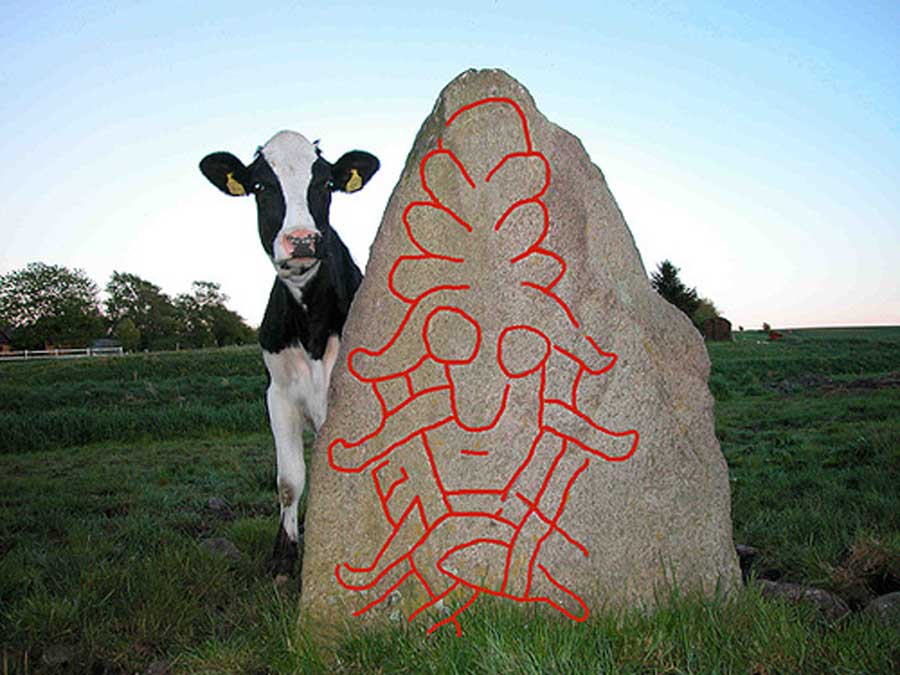Does a Viking Age Mask Stone Picture the Real Hamlet?
Does a Viking Age Mask Stone picture the real Hamlet? Surely not, the immediate reply might be. It is well-known that Shakespeare modeled his Hamlet story over older versions of the story about Amleth, first written in Latin circa 1200 AD by Danish chronicle writer Saxo Grammaticus. While Shakespeare’s Hamlet was a fictional renaissance character and the scene was set at Elsinore castle, Amleth was an actual person whom Saxo had been told about. Amleth lived on the Danish Jutland Peninsula, but according to Saxo before the Viking Age.

Saxo Grammaticus (Saxo), as imagined by Louis Moe, who illustrated the 1898 Danish translation. (Public Domain)
The Evidence Of A Viking Age Hamlet
Saxo’s story is placed in time before the Viking Age (before c. 800 AD). His story tells that the brethren Horvendil and Fenge, father and uncle of Amleth, were put in charge as chiefs of Jutland, the western part of Denmark, by king Rørik (Roerik). This king is described as the son of the god Odin, revealing the uncertainty of time, as this would have to be a mythical reference.
Saxo writing c. 1200 AD mixes saga with history, and he seems to have mixed Viking Age elements into Amleth’s story. Usually, Saxo is thought to be wrong on those Viking Age details. For instance, in a part of the story Amleth is sent on an errand to the king of England, with his uncle’s intent that he be killed there. Such an apparent out-of-time detail must be noted. But what if that detail is correct? This part becomes trustworthy if Amleth did live when the Vikings conquered the part of England called Danelaw.
- The Princes and Heroes Behind Shakespeare’s Hamlet, The Mad Prince Who Murdered His Uncle to Avenge His Father
- Bluetooth: Why Modern Tech is Named After Powerful King of Denmark and Norway
Let us take a look at Saxo’s Amleth story from this perspective, based on the assumption that the events actually took place in the Viking Age, one or two hundred years before Saxo. Locations near Amleth’s supposed burial ground in Ammelhede in eastern Jutland suddenly seem to logically relate to him, especially the Mask Stone at Sjellebro.
Amleth’s Final Resting Place
The fame of Shakespeare’s Hamlet increased the interest in the “real Hamlet” in Denmark. In 1933 proud citizens erected a stone on what was believed to be Amleth’s final resting place. Sadly, excavations only revealed a plundered Bronze Age grave.
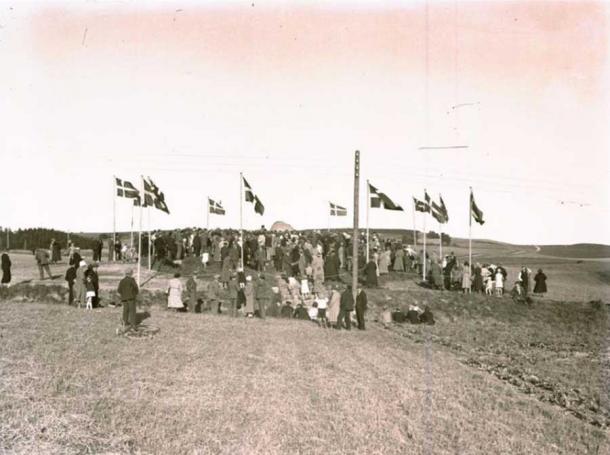
In 1933 proud local citizens and others erected a stone at Ammelhede, Denmark in memory of Amleth. (Unknown/ Author provided)
To be honest several locations in Denmark aspire to place of Amleth’s burial, but Saxo wrote that Amleth lay buried in a field carrying his name. The only location with a name resembling Amleth’s is the area around “Ammelhede” (Ammel Heath). That is, as said, if we question Saxo’s precision in time because he is known to have made mistakes in chronology.
Saxo’s Version Of The Amleth Story
The essential plot in Saxo’s version of the story is that Amleth’s father was killed by his brother, and Amleth suspects he is next to prevent him from revenging the murder of his father. Amleth pretends to be out of his mind, thus harmless. Secretly he scolds his mother for marrying her husband’s murderer, and several times he avoids the uncle’s attempts to call his bluff. One of the uncle’s attempts involves, as in a story of our age, a sex trap.
Amleth is sent to England to be killed slyly, but his two companions (read guards) are killed instead, because while on the sea Amleth discovered the order of his death, which was written in runes on a stick, and he changed the message.
Amleth returns to his father’s (now taken by his uncle) house a year later, on the day of a feast. Here, under the cover of night, he makes use of a lot of wooden hooks, he had previously cut while pretending to be a lunatic, to tie the wall blankets over his uncle’s drunken and sleeping soldiers, so they couldn’t escape the fire he lit, which burnt down the hall. Having exchanged his uncle’s sword with his own, made impossible to draw from its sheath, Amleth kills his uncle using the uncle’s own sword.
The drama and Amleth’s successful revenge pleased audiences of this early historical period. Already during his lifetime Amleth’s luck in “acting” or pretending must have given him a widespread popular reputation. The story was so popular that people were able to pass it on to Saxo centuries after the drama had taken place.
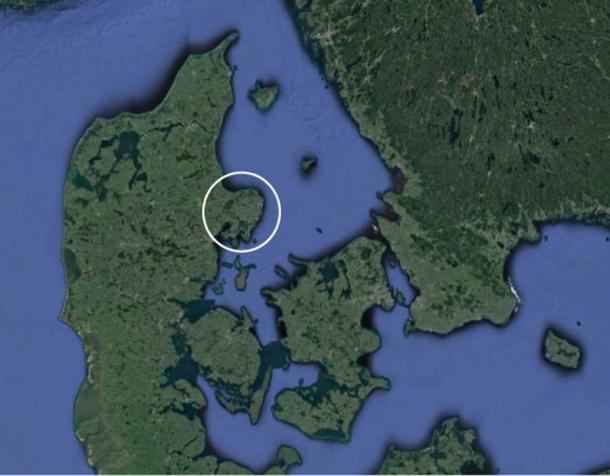
Denmark and the southernmost part of Sweden. The Djursland sub-peninsula is circled. (Google Earth)
The Djursland Peninsula
An ancient road crosses a small river about 3.5 km (2 miles) south of Ammelhede. The first road here at Sjellebro is dated from the Iron Age. It was marked by stones, but from roughly 750 AD the road was paved with wooden beams, which tells us it must have had substantial traffic importance as a main road to northern Djursland, as this sub-peninsula of Jutland is called, with a rather Swedish-sounding name ( Djur means animals in the Swedish language but not in modern Danish).
The Djursland peninsula lies in the middle of Denmark, which could explain its strategic importance in the Viking Age, and it has connection to Swedish parts of Viking Age Denmark.
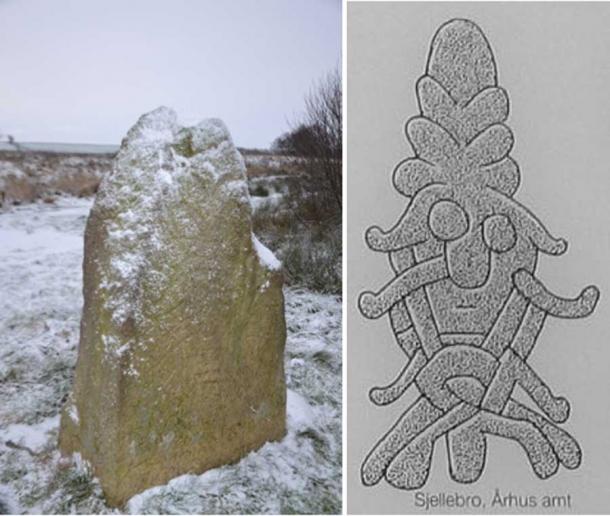
The Mask Stone possibly referring to the real Hamlet. The photo in the top of the article shows the mask lines drawn with red chalk. Photo here by author (left) and drawing by unknown author (right). (Unknown author / Travelling North)
Denmark’s Most Interesting Mask Stone Provides Clues
Markets were held at the Sjellebro crossing until c. 1920. Today, the modern macadamized road crosses the small river a few meters east of the old crossing, and there are no indications that this was an important location earlier. The old crossing road was discovered and excavated archaeologically after a farmer, in 1951, notified the National Museum about a stone there with lines. When erected, the full lines of a mask became visible, and the ancient road was discovered partly beneath it.
The Danish Mask Stone had no inscriptions like other rune stones with masks from the Viking Age. Based on its style, it is dated to 950-1050 AD.
I really cannot understand why nobody else has combined this mask stone with Amleth’s famous story. Masks from Greek theater could easily have been heard of in the Viking Age or earlier. The mask is an easily recognizable symbol for acting or for pretending: for wearing one facial expression on the outside while hiding your inner intentions. In my mind the Sjellebro Mask Stone perfectly depicts the famous actor Amleth. It is actually hard to think of a better way to depict him.
The Sjellebro Mask Stone may simply tell that you had entered “the Actor’s Land.”
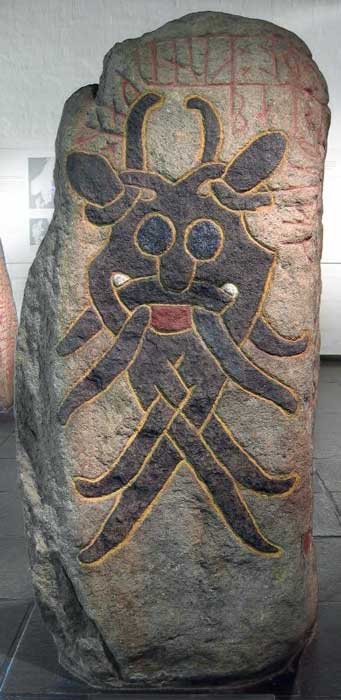
The Aarhus Mask Stone displays a very symmetrical mask with a happy or lunatic expression. The nose and eyes are very much like the Sjellebro Mask Stone. The runes say: "Gunnulfr and Eygautr/Auðgautr and Áslakr and Hrólfr raised this stone in memory of Fúl, their partner, who died when kings fought." ( Gardar Rurak / CC BY-SA 4.0)
Only A Few Mask Stones Have Been Found So Far
Relatively few mask stones have been found. The Sjellebro Mask Stone in eastern Jutland is special and may be the oldest, since it is standing alone with no inscriptions. A few mask stones have been found in earlier Danish parts of southern Sweden, and a few in mid Jutland. The most famous stone is the one found in Aarhus, where it was used as foundation stone for a water mill. Nobody knows where it originally stood. It is now part of the Moesgaard Museum collection. The mask serves as the museum’s logo!
- Why is Odin the New God of Choice for White Supremacists?
- Beautiful and Enigmatic Spirals of Golden Thread Uncovered in Denmark
How do we explain the existence of other mask stones, if the Sjellebro mask is linked to Amleth’s acting and to his local area? Can the other stones have been made in memory of relatives/descendants of Amleth? Or were they coming from his home ground in a kind of “local nationalism.” Or was it simply that a mask dedicated to Amleth became a popular image for people who liked to act or tell stories?
Perhaps we cannot claim the mask stone to have conclusive ties to Amleth, since it depends on Saxo being wrong in time, but it is as good a theory as the unreasoned one proposing the Aarhus mask shows warning symbols of an evil river spirit. This fantasy simply springs from the fact that the stone was found besides a narrow river, and nothing else. Could the stone just as well be an inland “border” stone, like we use for road signs between regions today? Even those who suppose the mask stone depicts a river monster, speak of it as a “mask stone.”
Why not realize that it is a mask, and ask why anyone would erect a stone with a mask and nothing else?
It is a good idea to look at the area and Amleth’s story with a fresh perspective.

Nowadays topographic map of Djursland gives an idea of how northern Djursland was almost separated from Jutland earlier by waterways. Since the Ice Age the land has risen slowly. In the Viking Age a fiord stretched from Grenaa in east to the mask stone in west, with a connection to northern waterways too. (Google maps).
Finding Answers In Amleth’s Homeland
Assuming the Sjellebro Mask Stone is a key to a new view on “the original Hamlet,” several other Viking Age details may be connected and further enlighten the story. The most important is that this might not only be the area he died in, but the area he actually lived in.
Supposing the mask stone functioned as a kind of regional border stone, Amleth’s home ground can be limited to the northern part of Djursland. In his age, Djursland was nearly parted in two by the long Kolindsund fiord. Most of it has turned into low drained field land since. Therefore today, Djursland is a single, continuous piece of land, instead of two.
Northwards from the Sjellebro Mask Stone there was less than 5 kilometers to the next separating waterway, the outlet of Denmark’s longest river, the Gudenå ( “The God’s River”). The road and bridge at Sjellebro crossing must have been one of a few ways to reach northern Djursland by land, and hence a well-chosen place for a roadside border marker.
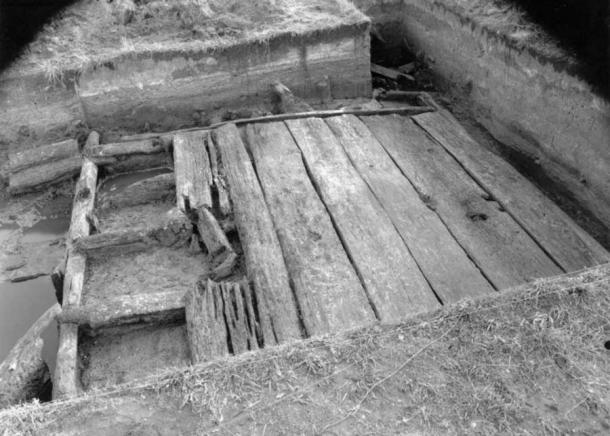
Archaeological excavation in 1953 of the Viking Age road and bridge at Sjellebro (Sjelle Bridge). (G. Bibby / Lime Egnsarkiv)
A Rich Viking Woman’s Grave
Before the modern road was made, the road north from the mask stone passed through the village of Hørning (Hoerning). This village had a wooden church in the Viking Age at which a wealthy woman’s grave from c. 1000 was excavated (small bits of cloth with silver threads woven into textile survived). While we cannot say whether this grave was for a relative of Amleth, the grave proves that this area was home to some wealthy Vikings.
Canute The Great
In 1016 Canute/Cnut the Great won the English throne, and in 1018 also the Danish crown. In 1028 he claimed the Norwegian crown, and in 1031 the Scottish King Malcolm II submitted to him for a few years. This last Scottish connection is interesting, because according to Saxo, Amleth returned from England the first time having married the English king’s daughter, and some years later after his revenge, when returning to England again, he also married a Scottish princess. This could rather precisely place Amleth’s story in time.
King Canute himself married king Ethelred’s widow and wished the peoples to blend peacefully. Another way he tried to maintain peace in his land was to build churches in England, and maybe the Virring Church near Ammelhede in Denmark. This timeline is supported by the expansion of the Christian faith in the region.
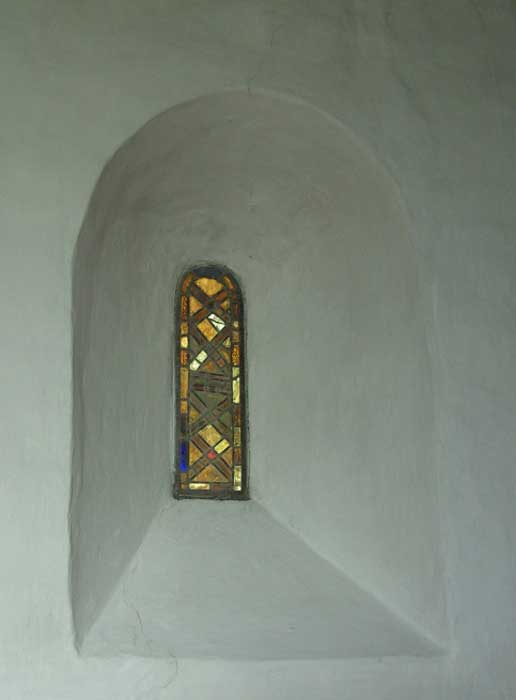
The oldest stained-glass window in Scandinavia, in timeless beauty. (Photo by author)
Virring Church
This church is located further north, but quite close to Ammelhede. Virring Church is one of the four oldest stone churches built in villages in Denmark. It is remarkable as it was built in the British style (supposedly c. 1070). Do we owe the church to Amleth, paying back a debt for the help he received from England?
Virring Church is by the way my favorite church. It is interesting for several reasons. It lies on a sloping hill with a nice panorama to the south. It has the oldest (c. 1300) stained glass window in Scandinavia. It is small but beautiful in its simplicity. Looking from the inside out to the sky, tranquility easily descends on you. You leave the window with a puzzled feeling you have just experienced something important.
If Amleth died at Ammelhede close by, his dead body could have been re-buried in or by Virring Church when it was finished, this being the reason no body was found at Ammelhede.
And there are mysteries connected to this church. To read more about an interesting gravestone kept in the church porch and symbolism in this church, connected to alchemy symbolism built into the manor it belonged to, you may read my article Gammel Estrup Manor: Alchemy, Astronomy, and Secret Symbolism Revealed. The manor museum is worth a visit if you happen to pass this way.
Rougsø
Having dealt with my primary subject and reason for writing this article, I cannot restrain from finishing the article by bringing forth some connected looser speculations on the area that could also be linked to Amleth’s home ground.
The landscape has changed since the Viking Age. There were more waterways then, all being important for the sailing Vikings. As mentioned above, all the way from the eastern tip of Djursland a fiord (Kolind Sund) reached deep into or bordered what may have been Amleth’s land. But closer to the north, a site by a now former waterway, may have been the scene for the dramatic events.
On the other (northern) side of the long hill, which Ammelhede is part of and Virring Church stands on, you have a view to Randers Fiord, the outlet of the Gudenaa River. In Amleth’s age, the Gudenaa River had a second eastern outlet, isolating Rougsø Island (ø=island) from the mainland. This Roug’s Island has a very strange name.
Locals propose it means island of roses, or that Roug was the name of a bandit chief living here in the past. In Danish Roug is pronounced in the back of the mouth as the word rov, which means something stolen.
Can this be linked to Amleth’s uncle’s crime: stealing home, mother and the whole island from Amleth? Then this island may have been where it all happened.
Agreed, it is wishful thinking… perhaps because I live here.
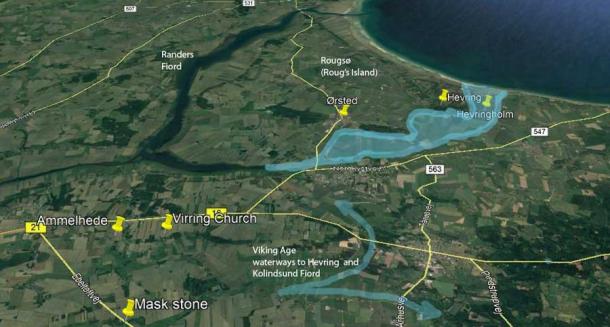
Google earth image with mentioned locations pinpointed. The former outlet east of Rougs Island has been added in blue. (Created by the author with Google Earth and Photoshop)
Viking Age Locations
Village names ending in –sted or –ing reveal Viking Age origins, like the mentioned Hørning and Virring, and also Ørsted and Hevring, both at the former eastern outlet.
On the one-time island’s southern side, 10 km/6 miles from Ammelhede, lies the village of Ørsted (Oersted). Ørsted had a bulwark, and a Viking Age well has been excavated there. But closer to the sea you find the village of Hevring, and close to this village the Hevringholm manor (a holm is more or less a separated small island stretching into the water). The first Hevringholm manor was lying almost out in the former eastern outlet of Randers Fiord, which was sailable until c. 1300. The story goes that this manor had roots in the Viking Age. It was rebuilt in about 1800 on top of a hill, but in the Viking Age it lay by the water.
- Was It Just a Boss Spying on His Workers? First Viking Age Tower Found in Denmark
- Ancient Greek Theater and the Monumental Amphitheaters in Honor of Dionysus
I cannot help but speculate: Was this (or Ørsted) the residence of Horvendil? Because Amleth would very likely have settled down in the vicinity of his foster home, but not necessarily in the more or less burnt-down crime scene.
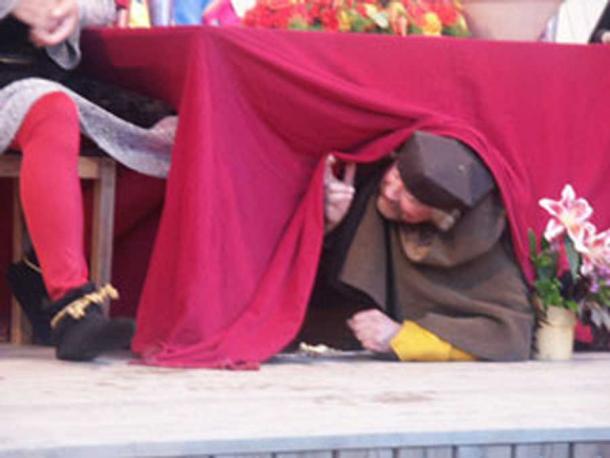
The author acting in Papa Razzi as a spy from Rome. (Photo provided by the author)
Local Play
My main reason for fantasizing about especially Hevringholm is that it completes a circle for me personally. The above photo shows me having a small role (Papa Razzi, a spy from Rome) in a local open-air amateur play in my village of Hevring, twenty years ago. The play was a humoristic version of Hamlet. We had written the play to take place at Hevringholm.
Without knowing it we could have been closer to the true Hamlet story than we could ever imagine. Sometimes fate directs us in mysterious ways.
Top image: The Sjellebro Mask Stone with lines drawn in red chalk. Source: Lime Egnsarkiv
By Niels Bjerre Jorgensen
References
Gesta Danorum by Saxo Grammaticus, written c. 1200. An English version: David Fisher & Hilda Davidson’s Saxo Grammaticus: The History of the Danes, Books I-IX, published by Boydell & Brewer.
http://tabletweaving.dk/wordpress/wp-content/uploads/2015/03/Nationalmuseets-Arbejdsmark-1999.pdf


















